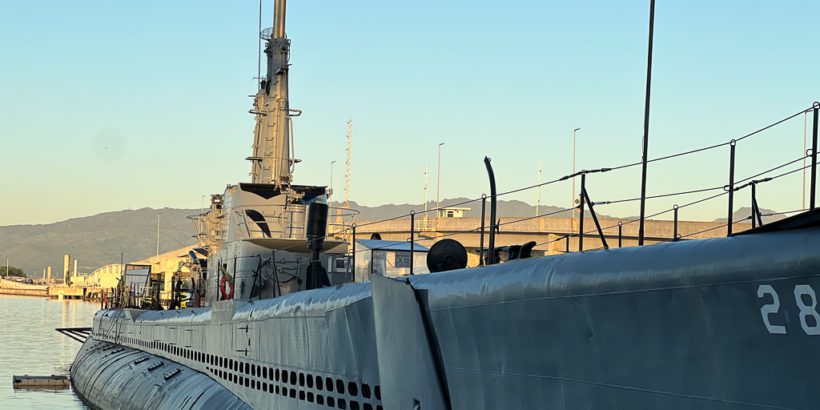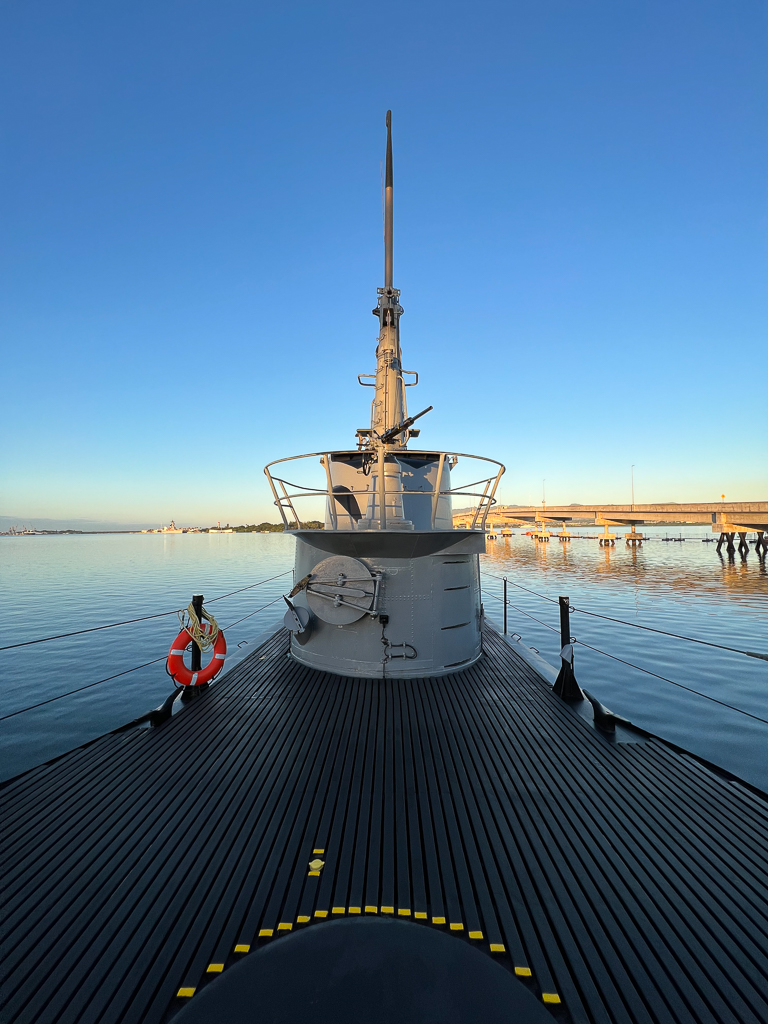One of the must-see attractions when visiting Pearl Harbor in Hawaii is the USS Bowfin submarine.
It’s one of the only places where you can actually go inside the tight quarters of a submarine from World War II and it’s a really cool experience, especially if you’ve never even seen a submarine before.
Below, I’ll give you some tips and guidance so that you will be prepared for your USS Bowfin Submarine visit.
Table of Contents
Pacific Fleet Submarine Museum campus overview
The Pacific Fleet Submarine Museum campus is one part of the Pearl Harbor experience and it’s home to the:
- The USS Bowfin submarine
- Pacific Fleet Submarine Museum
- Park with outdoor artifacts
- Shaded eating area and food truck
- Gift shop
In my personal opinion, the USS Bowfin submarine is the primary attraction here but the museum is also pretty cool, too. This article will just focus on the USS Bowfin Submarine experience.
Tip: If you want to buy tickets to multiple Pearl Harbor attractions (USS Bowfin, Pacific Aviation Museum, and Battleship Missouri) check out this option online.

How to visit the USS Bowfin Submarine
The USS Bowfin Submarine is located on the north side of the Pearl Harbor National Memorial area. After you go through the main entrance, you will head to the right to make your way to the submarine.
You should see signs pointing you the right way but basically it’s on the opposite side of where you line up for the USS Arizona shuttle boat.
It’s pretty close to where you hop on the shuttle bus to take you over to Ford Island where you can visit the USS Missouri, USS Oklahoma Memorial, and Pearl Harbor Aviation Museum.
Related: Pearl Harbor Ultimate Guide
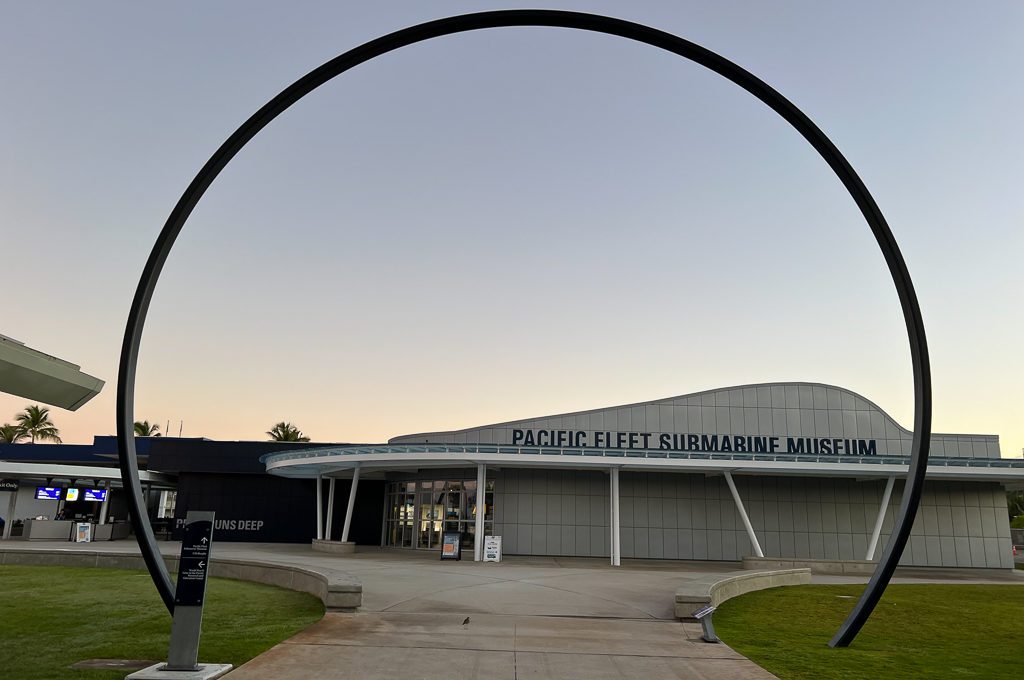
You will need to buy tickets in order to visit the USS Bowfin and here are the prices for the tickets:
• Adult General: $23.99
• Children General (4-12 years): $13.99
Military members and Kama’aina can get discounts.
You can buy these online or you can buy them whenever you get there but I would advise you to just secure them online.
You’ll have to select the date of your visit but you do not have to lock in a specific time slot.
You can choose to do an audio tour if you’d like (they have a kid’s version and an adult’s version). If you don’t do the audio tour, you should be able to get through the submarine in about 30 to 45 minutes.
Once you have your tickets, you can bring them in printed form or digital form on your mobile device and someone at the entrance of the museum area will scan them and let you in.
The good thing about these tickets is that you can leave and come back.
So let’s say that you had a tour of the USS Arizona coming up and you need to head over there to catch your shuttle, you could always just come back later on and see the rest of the USS Bowfin submarine area that you missed.
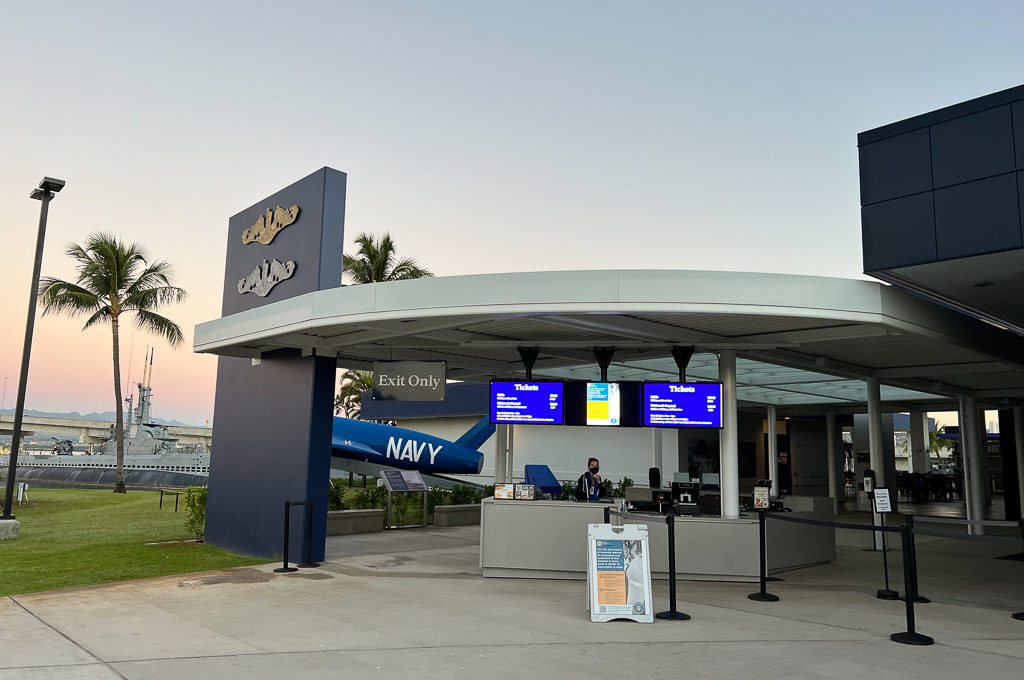
USS Bowfin submarine history
The USS Bowfin launched on December 7, 1942, exactly one year after the attack on Pearl Harbor, which is why she is known as the “Pearl Harbor avenger.”
In World War II, the USS Bowfin conducted nine war patrols between 1943 and 1945 and most of her patrols were in the South China Sea, Celebes Sea, off the East coast of Japan, and into the Sea of Japan.
Each patrol was a couple of months long and you never quite knew what to expect.
Some patrols were almost entirely uneventful with no confirmed hits on vessels while others were insanely busy with many close calls from depth charges.
I’d recommend you check out this history that chronicles all of the different patrols.
You get a sense of the cat and mouse game that the submarines played with other vessels and also an idea of how many torpedoes simply missed or malfunctioned in some type of way.
Looking at all of the combined patrols, the USS Bowfin did a lot of damage
The Bowfin’s four commanding officers believed she sank 179,646 tons (including 34 large vessels) but the Joint Army-Navy Assessment Committee (JANAC) credited Bowfin with 67,882 tons sunk (16 vessels of that tonnage plus 22 smaller craft).
Regardless of the exact figure, the fact that she had so many successful patrols and made it back so many times is significant.
Submarines were one of the most dangerous places you could be during World War II and they had one of the highest fatality rates (1 in 5).
In many ways, because World War II was the most fatal war for submariners in US history, the USS Bowfin is a memorial to all of the submariners who lost their life in “silent service” during World War II.
And that’s fitting considering the USS Bowfin is considered to be the best preserved and most visited submarine that served during World War II.
The USS Bowfin Submarine experience
Once you verify your tickets you have the opportunity to choose which submarine attraction you want to visit first and I would personally recommend going to the USS Bowfin submarine first.
You’ll take the walkway to the deck of the submarine and then you’ll see an entry hatch to take a steep stairway ladder down.
Watch your head as you enter and as you make your way through all of the different compartments.
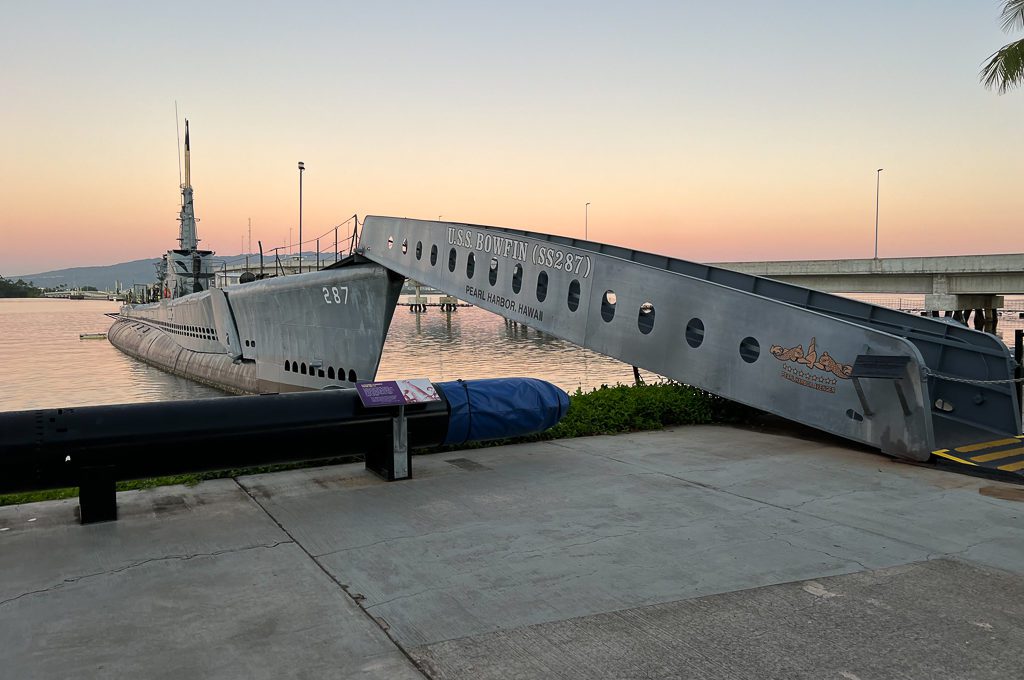
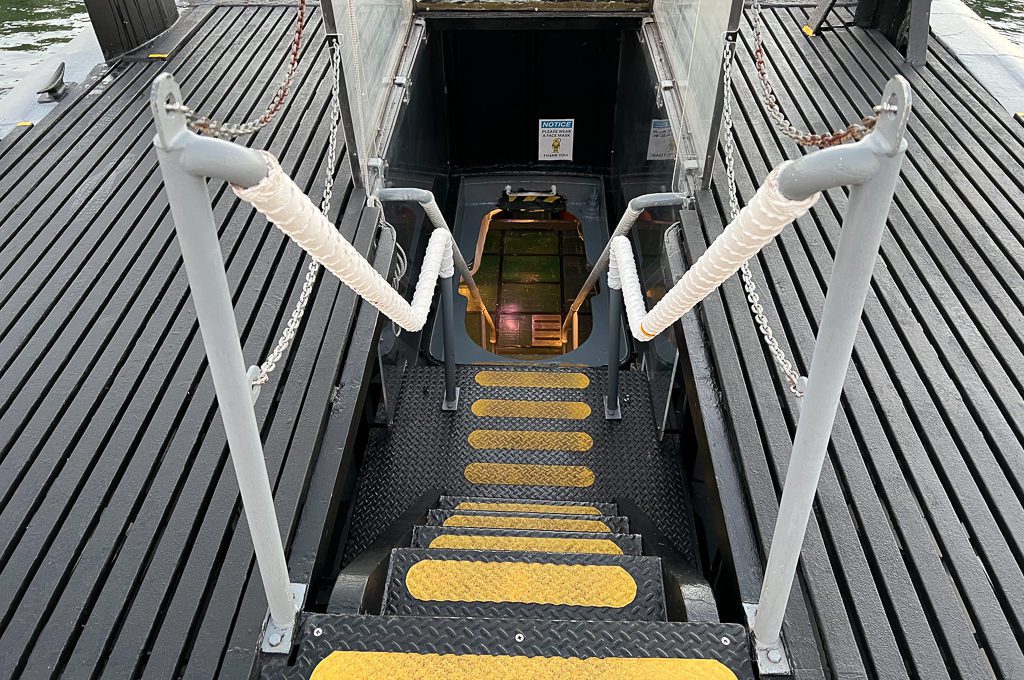
Immediately, we dropped into the forward torpedo room, where bunks were literally on top of torpedoes which was just wild.

Apparently, these bunks became prime real estate because they are so far removed from their busy corridors in the middle of the submarine.
Not only would they be quieter but also cooler since they were farther away from the engine room. To help the sailors sleep, only a red light would remain on in this dark compartment.
I never realized that submarines had both front and aft (back) side torpedoes so they could launch them in either direction.
In total, the sub would carry 24 torpedoes, which doesn’t really sound like a lot when you consider that they would be underway for two months but it just goes to show how selective they had to be with their targets.
At the end of the forward torpedo room, you’ll see the officer’s head (bathroom area) and from there, you’ll head into the forward battery compartment.
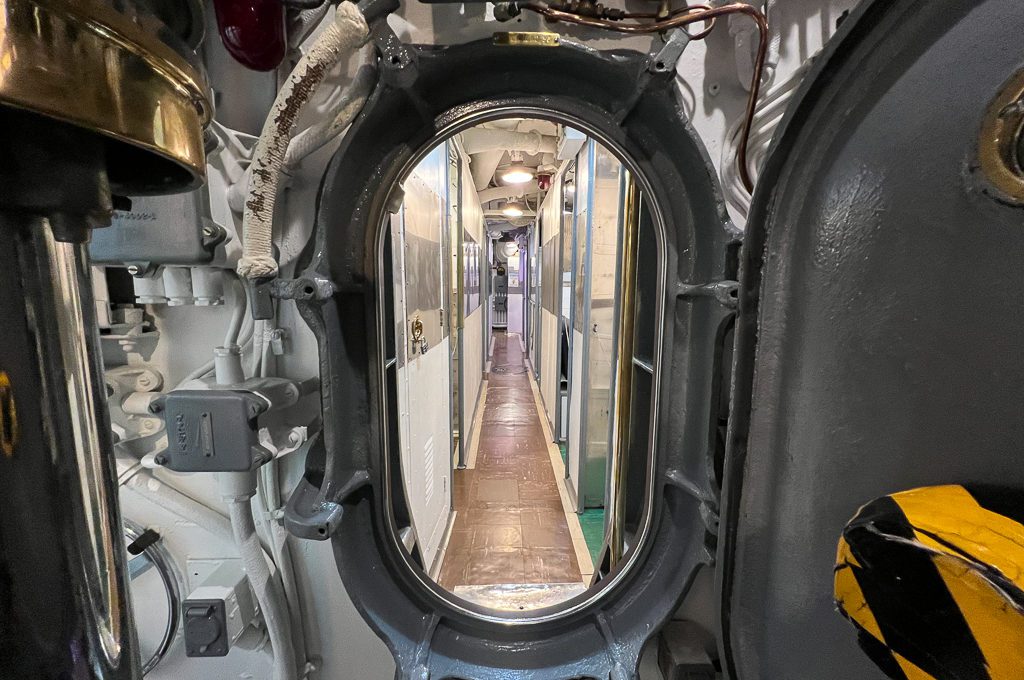
You’ll see the ward room which is where the officers ate their meals and across from that you’ll also see where they slept (berthing area).
Although the officers had their own eating area, everyone on the submarine apparently ate the same food.


Next, you’ll come across the stateroom which is where the captain slept. The lucky captain was the only sailor to have his own personal bedroom.
Considering the magnitude of the decisions he had to make on a daily basis, it’s probably a good thing he got some good rest in a private room.

Next is the “ship’s office” which is basically a closet where someone worked on a typewriter and helped keep track of all of the admin tasks. It’s pretty tight working quarters but what would you expect on a submarine?

After that, it’s time to head through another portal to the control room.
This is where they controlled the steering of the ship and also initiated the dives when it was time for the submarine to submerge.
The goal was for them to submerge in less than one minute. Every second counted.
After reading some of the patrol reports, I realized just how up-and-down the submarines would be during battles at sea.
I can’t imagine the adrenaline and focus flowing through this room during those times as they rode out depth charge explosions for hours.
Prepare to be overwhelmed by the sheer number of controls and valves located all around you.
Keep in mind that all of the different stations were manned by different sailors and when it came to things like surfacing or submerging, there needed to be perfect synchrony to avoid any catastrophic outcomes.
It’s no surprise then that submariners were some of the best sailors as it wasn’t easy to become one.
If you were one of the lucky volunteers who were accepted to serve in submarines, you did receive a nice pay raise, though.

There’s a ladder in this room that heads up to the conning tower, which housed all of the equipment needed for an attack such as the radar, periscope, torpedo data computer, etc.
It was from this room that all of the damage was done to the enemy.
Unfortunately, this was not open to us on our visit.
I don’t know if access is limited because of coronavirus or because only special guided VIP tours offer access to that but it would’ve been really cool to go up in there and check that room out.
Note: They have a conning tower from the USS Parche in the outdoor part of the museum you can check out.
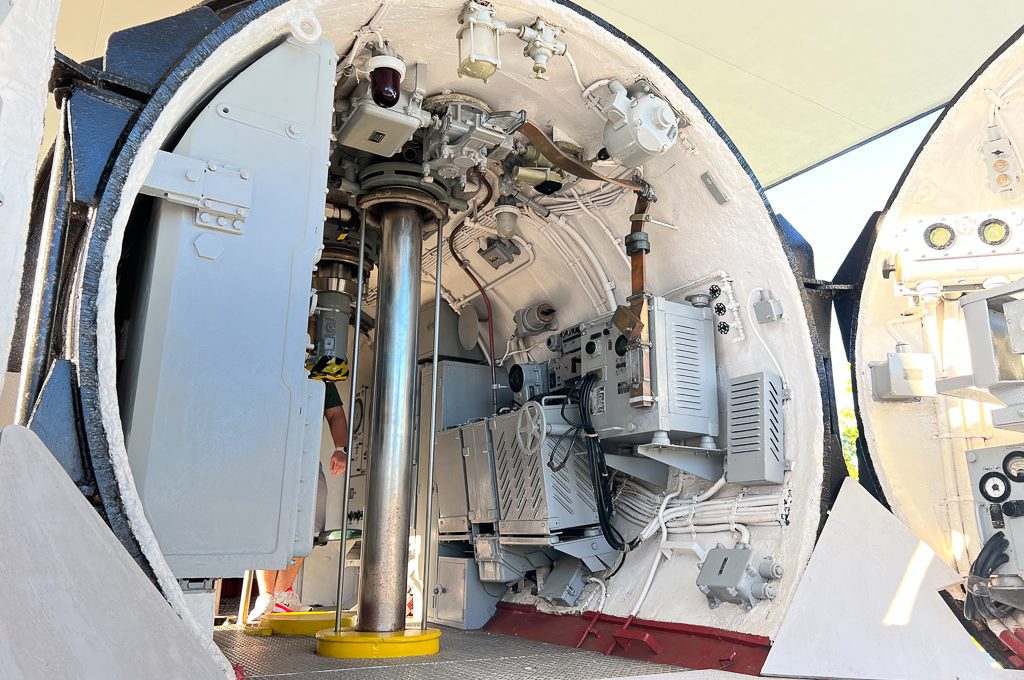
So without going up, we proceeded through another water tight doorway and into the galley which is where most of the crew had their food cooked.
It’s reported that the food was actually quite good which is in line with what I once heard from someone who served on a submarine.
I think it’s partly because they don’t have to mass produce the food like they would on a big battleship or carrier but also largely because they needed to keep the crew in good spirits considering that they could go weeks without surfacing sometimes.
While the submarine was underway, this area remained manned at all times and served up four meals a day.
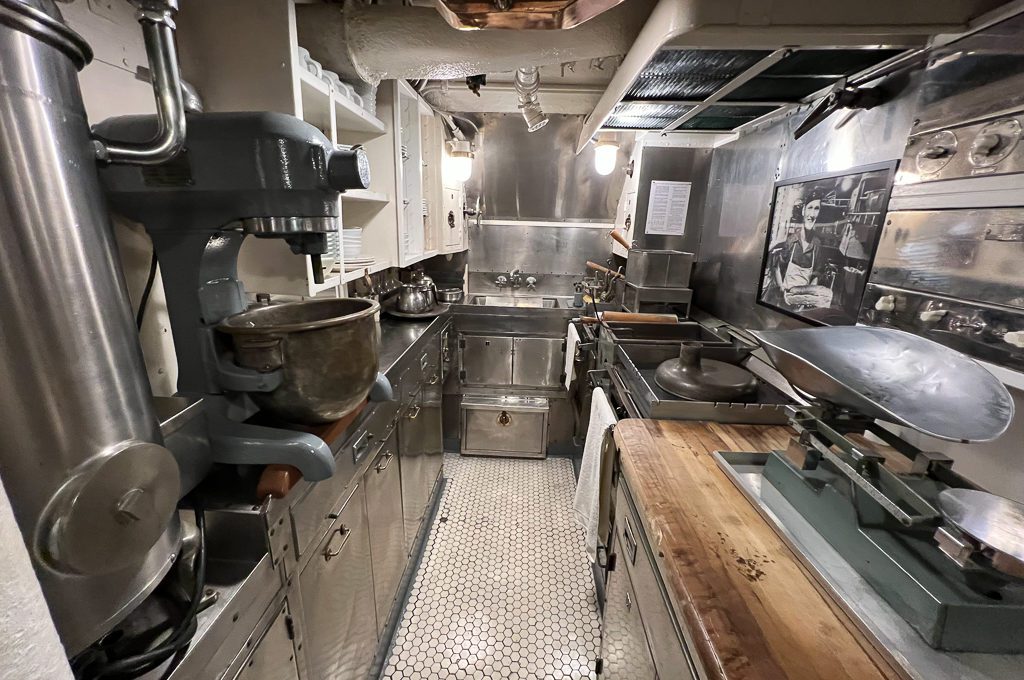
Here’s where the crew would eat or just socialize between meals.

Right past the mess area is where the main bunks were for the crew (berthing area).
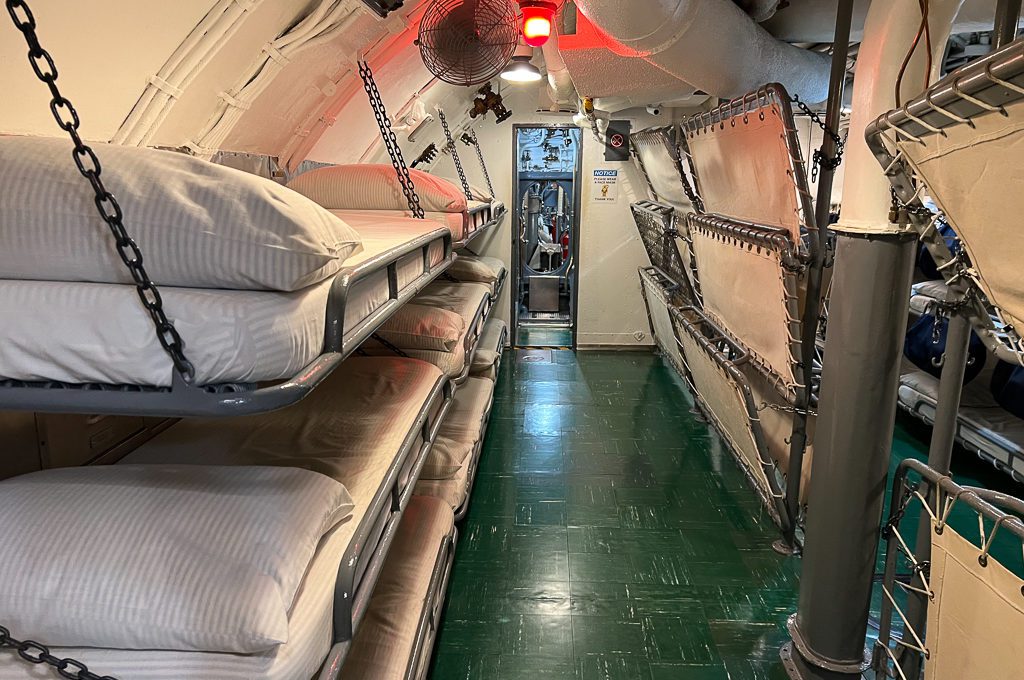
You then get a look at the crew’s heads (or bathrooms).
On some ships, it wasn’t uncommon for sailors to only shower once every two weeks or so. With an 80 man crew, you can imagine how things probably smelled throughout the ship weeks into a patrol.

Next, you’re headed to the forward engine room, where two of the main diesel engines are located, which I’m assuming was both hot and loud.

Right through there is the next compartment which is the aft engine room where the other two diesel engines are located.
Diesel engines only ran whenever the submarine was at surface and when submerged it was all electric. That battery power was finite so submarines had to be careful to not get stuck underwater without power.
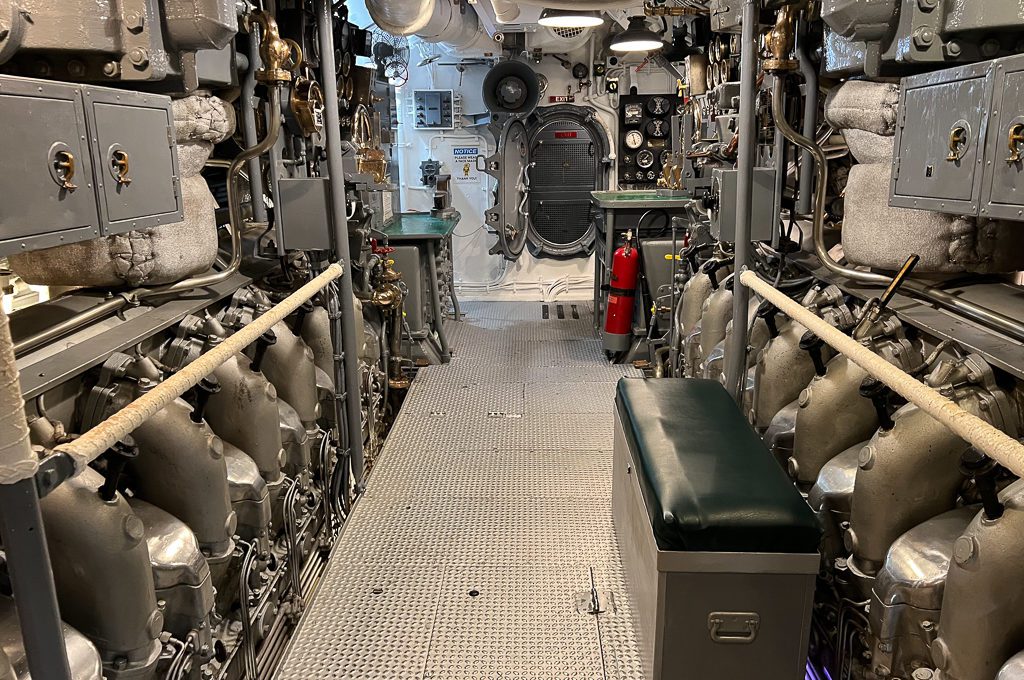
And then finally we entered the aft torpedo room.
It’s in that room where you’ll find the exit ladder to make your way back to the deck of the submarine.
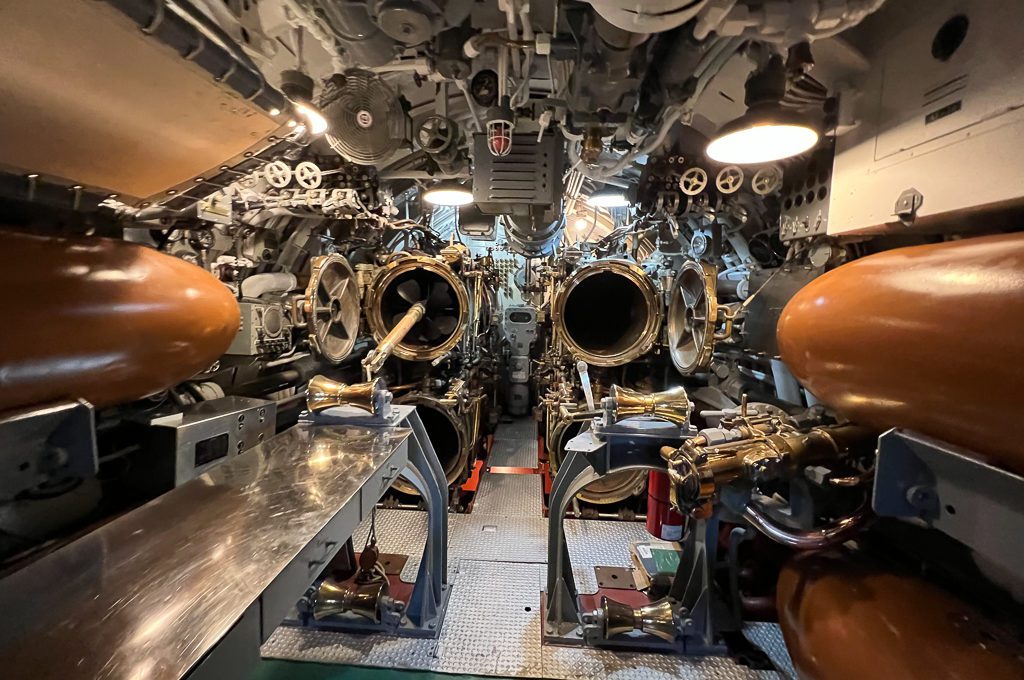
Up top on the main deck, you can check out the 5″ deck gun which was used whenever torpedoes were not worth the effort, such as when firing on smaller merchant ships.
This was especially true later on in the war when the Japanese ran out of steel ships and were shipping resources on old wooden ships.
You can also see the radar mast and radar antennas, which were things that gave the US a major advantage during World War II.
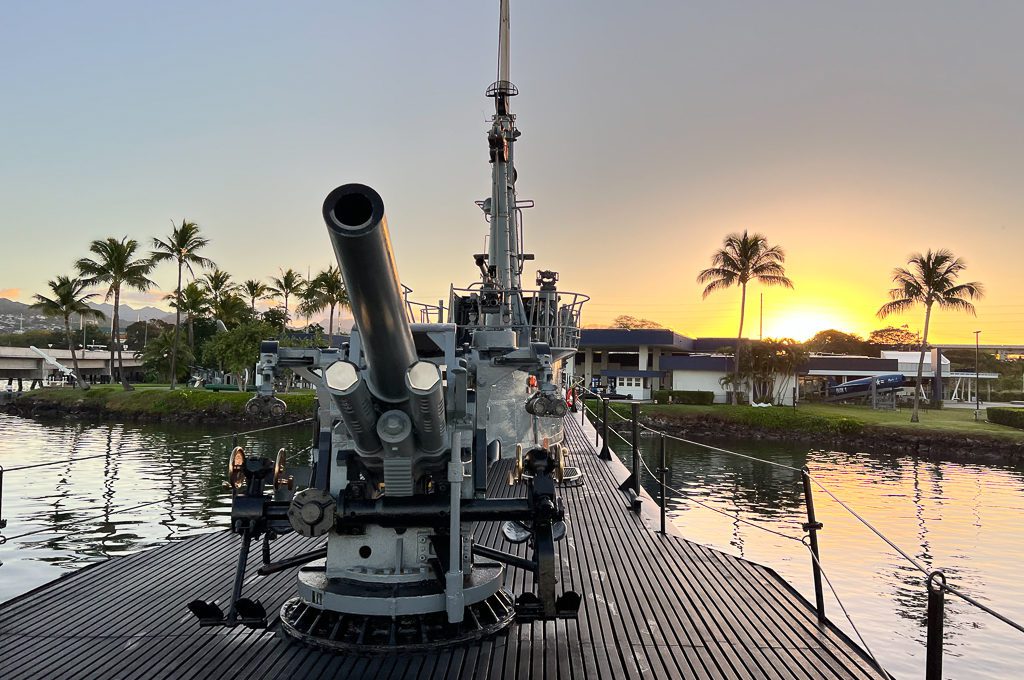
You can also climb up on the bridge where there is another gun and see the exact type of view the sailors would’ve had.
Interestingly, a lot of the fleet submarines had different variations of guns because commanders could choose how they wanted them to be equipped and the types of guns they wanted to use.
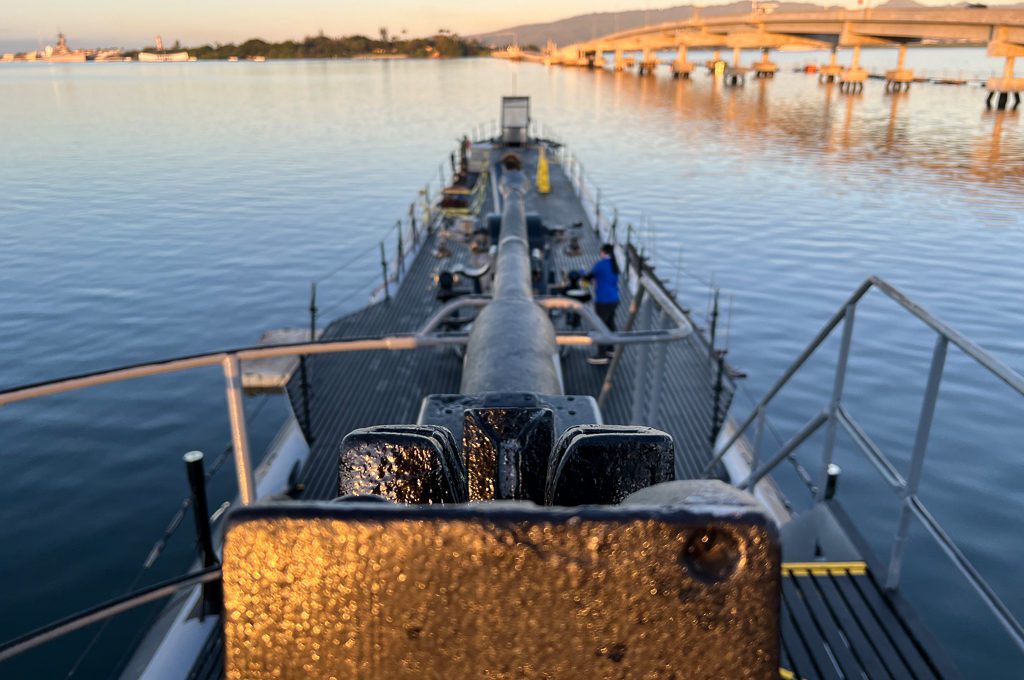
Most of the time torpedoes were fired when the submarine was submerged but they would sometimes fire torpedoes when surfaced, especially at night.

When on the surface, there would’ve been two people on lookout on top of the bridge who were tasked with the duty of watching out for all of the crew. There was no room for error and slacking off on your watch could mean the difference between life and death.
Final word
Overall, the USS Bowfin was a really cool experience.
It probably would have helped to have the audio guide but I still enjoyed being able to explore on our own especially because we had the submarine to ourselves at 7am.
If you don’t choose to do the audio tour, this article should give you enough detail to appreciate what you’re seeing and hopefully you’ll enjoy checking out this submarine as much as I did.
Daniel Gillaspia is the Founder of UponArriving.com and the credit card app, WalletFlo. He is a former attorney turned travel expert covering destinations along with TSA, airline, and hotel policies. Since 2014, his content has been featured in publications such as National Geographic, Smithsonian Magazine, and CNBC. Read my bio.

